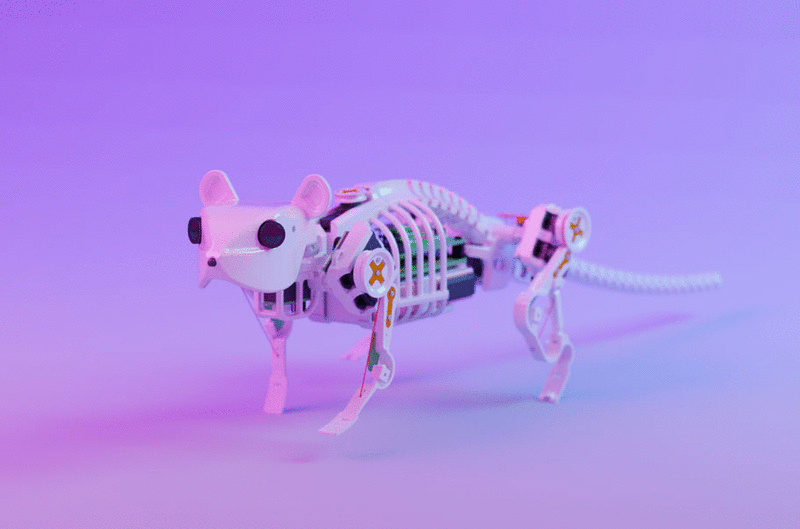Bridging the gap between nature’s designs and human ingenuity, a newcomer in the field of robotics is making waves. Dubbed NeRmo, short for Neurorobotic Mouse, this creation blends biology and robotics. A joint venture between the Technical University of Munich (TUM) in Germany and Sun Yat-sen University in China, NeRmo is a great example of how robotics can draw inspiration from nature.
Spearheaded by Zhenshan Bing, an Associate Research Scientist at TUM, the team focused on mimicking the agility and movement efficiency of biological mice. NeRmo, a quadruped robot, stands out for its strong adaptability to complex terrains and a unique soft-actuated spine capable of lateral flexion. This spine, a critical innovation, sets NeRmo apart from conventional high-tech robots, typically limited by stiffness that restricts their movements. Instead, NeRmo can walk faster thanks to longer stride lengths enabled by lateral flexion.
Biomimicry in robotics
NeRmo’s components, including its spine, are created with 3D printing. The team leveraged selective laser sintering (SLS), a method chosen for its ability to produce parts that are resilient and compliant. The SLS process allowed the production of parts from materials like Nylon, which are ideal for their durability and flexibility. These materials are especially well suited to create flexible joints and complex structures designed to move through wide angles, as NeRmo’s design showcases.
The use of 3D printing in developing NeRmo was vital, not just for how it functions but also for making it more lifelike. The accuracy and customizable nature of 3D printing enabled the team to replicate a mouse’s body accurately, from its spine to its limbs. This attention to detail even includes the biomimetic robot‘s movement system, which copies a rodent’s muscles and tendons, adding to its lifelike design. One of the standout feature of NeRmo is this tendon-driven movement system, which is very similar to how muscles and tendons work in a rodent. The design team matched the size and shape of the robot to those of the common rat, enhancing its lifelike quality. Moreover, the creation of NeRmo represents a significant advance in the field of robotics.
 The neurorobotic mouse NeRmo. Image courtesy of Zhenshan Bing/Technical University of Munich.
The neurorobotic mouse NeRmo. Image courtesy of Zhenshan Bing/Technical University of Munich.From concept to reality
According to a study published by the team in the journal Science Robotics, titled Lateral flexion of a compliant spine improves motor performance in a bioinspired mouse robot, NeRmo is packed with technical innovations. The robot has a central body frame that holds all its parts, like the tail, head, and legs. This frame also contains a special area for the battery, a Raspberry Pi computer, and a tailor-made “spine” adapter board. This board is key for connecting all the sensors and motors, making it easier and more efficient to put the robot together.
 The Neurorobotic Mouse NeRmo. Image courtesy of Zhenshan Bing/Technical University of Munich.
The Neurorobotic Mouse NeRmo. Image courtesy of Zhenshan Bing/Technical University of Munich.NeRmo’s Impact
Backing for the NeRmo project came from the European Union’s Horizon 2020 Framework Programme for Research and Innovation under the brain research initiative Human Brain Project. Additionally, Pazhou Lab in Guangzhou, China, a hub for AI and digital economy research, also contributed to the project’s financial support. This lab, known for advancing AI research and promoting industrial development, played a key role in funding the project.
All these efforts have led to the creation of the robotic mouse NeRmo, which not only resembles a real mouse in appearance but also matches its agility and efficiency. The side-to-side bending ability of NeRmo’s flexible spine significantly enhances its movement capabilities, improving its balance, walking speed, and turning skills. This breakthrough in robotic design opens new possibilities in the realm of four-legged robots with spine-like structures, establishing a new standard for future robots that are both agile and efficient.
Subscribe to Our Email Newsletter
Stay up-to-date on all the latest news from the 3D printing industry and receive information and offers from third party vendors.
You May Also Like
Gorilla Sports GE’s First 3D Printed Titanium Cast
How do you help a gorilla with a broken arm? Sounds like the start of a bad joke a zookeeper might tell, but it’s an actual dilemma recently faced by...
Nylon 3D Printed Parts Made More Functional with Coatings & Colors
Parts 3D printed from polyamide (PA, Nylon) 12 using powder bed fusion (PBF) are a mainstay in the additive manufacturing (AM) industry. While post-finishing processes have improved the porosity of...
$25M to Back Sintavia’s Largest Expansion of Metal 3D Printing Capacity Since 2019
Sintavia, the digital manufacturing company specializing in mission-critical parts for strategic sectors, announced a $25 million investment to increase its production capacity, the largest expansion to its operations since 2019....
Velo3D Initiates Public Offering in a Bid to Strengthen Financial Foundations and Drive Future Growth
Velo3D (NYSE: VLD) has been among a number of publicly traded 3D printing firms that have attempted to weather the current macroeconomic climate. After posting a challenging financial report for 2023,...































